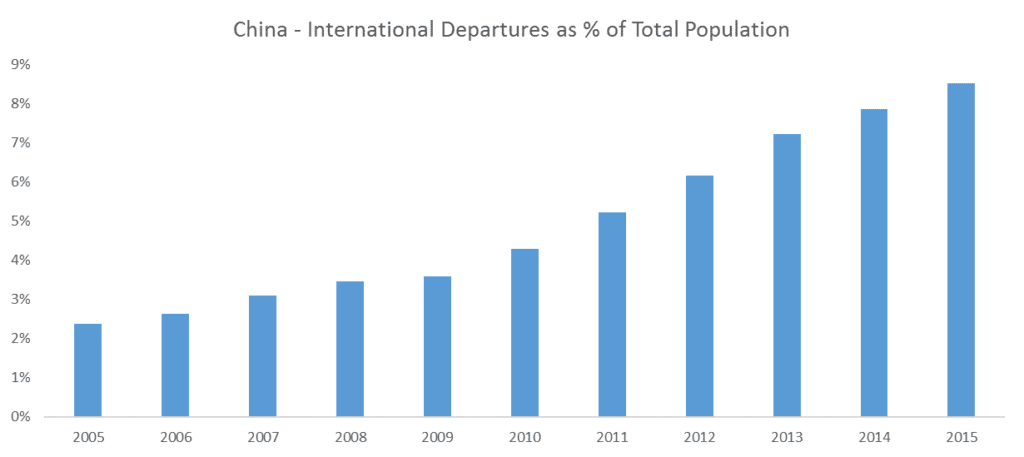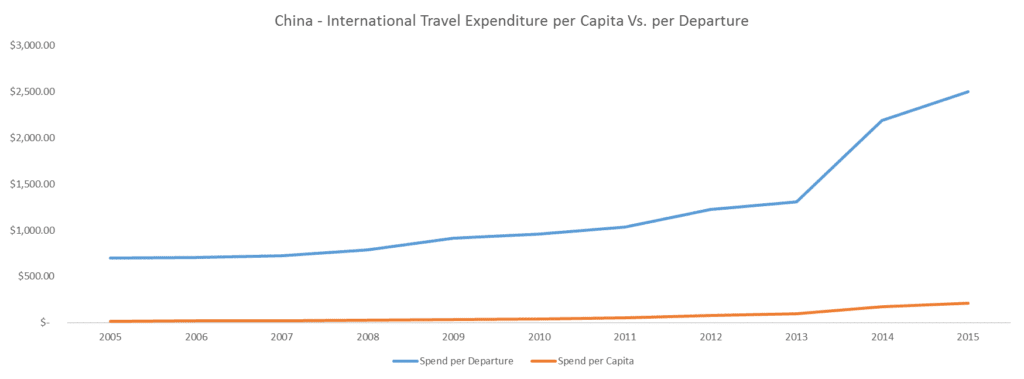China Outbound Travel Spending Disparity Shows Enormous Growth Potential
Skift Take
Here's an interesting fact you haven't heard much about the explosive growth of outbound Chinese travel: The overall Chinese population isn't sharing that much in the trend.
In other words, in China the amount spent by outbound travelers as a percentage of gross national income per capita is far lower than in the UK, France and Germany.
That is probably to be expected when comparing a developing country like China and European economies, and also shows the great potential for growth in Chinese outbound- traveler spending.
Last week we launched the latest report in our Skift Research service, Key Emerging Outbound Travel Markets 2017.
Below is an excerpt from our Skift Research Report. Get the full report here to stay ahead of this trend.
China has been growing not only in terms of total international travel expenditures — or spend by its outbound travelers — but also by number of departures. Yet looking at the growth in international travel expenditures on a per capita basis compared to international travel expenditures per destination the country still shows a vast divide between the two.
In 2015, spend per departure amounted to roughly $2,500 while spend per capita was at just $213. The larger the gap between the spend per capita and spend per departure the more unlikely it is that the average citizen participates in international travel at all. In saturated travel countries, the spend per capita can be higher than the spend per departure, indicating that on average everyone participates in international travel at least once per year.
Preview and Buy the Full Report
 Source: World Bank Data and UNWTO.
Source: World Bank Data and UNWTO.
 Source: World Bank Data and UNWTO.
Source: World Bank Data and UNWTO.
Preview and Buy the Full Report
Contrasting the spend per departure with gross national income per capita shows the percentage of gross national income a typical departure makes up. In saturated countries such as Germany, France and the United Kingdom, a departure typically makes up between four and six percent of gross national income per capita.
In China, in 2015 spend per departure made up 31 percent of gross national income per capita, thus making up just under one-third of the average Chinese income. With a low gross national income per capita, it’s unlikely a citizen will be able to, or willing to, spend one-third of their annual earnings to participate in international travel.
 Source: World Bank Data and UNWTO.
Source: World Bank Data and UNWTO.
Subscribe now to Skift Research Reports
This is the latest in a series of research reports, analyst calls, and data sheets aimed at analyzing the fault lines of disruption in travel. These reports are intended for the busy travel industry decision maker. Tap into the opinions and insights of our seasoned network of staffers and contributors. Over 200 hours of desk research, data collection, and/or analysis goes into each report.
After you subscribe, you will gain access to our entire vault of reports, analyst calls, and data sheets conducted on topics ranging from technology to marketing strategy to deep-dives on key travel brands. Reports are available online in a responsive design format, or you can also buy each report a la carte at a higher price.




